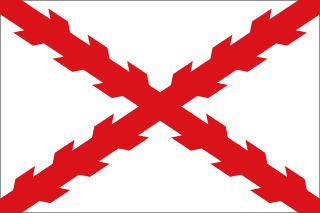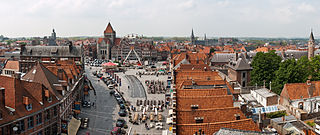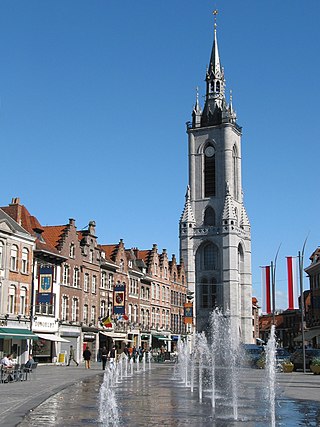
Ghent is a city and a municipality in the Flemish Region of Belgium. It is the capital and largest city of the East Flanders province, and the third largest in the country, after Brussels and Antwerp. It is a port and university city.

The Scheldt is a 435-kilometre-long (270 mi) river that flows through northern France, western Belgium, and the southwestern part of the Netherlands, with its mouth at the North Sea. Its name is derived from an adjective corresponding to Old English sċeald ("shallow"), Modern English shoal, Low German schol, West Frisian skol, and obsolete Swedish skäll ("thin").

The Seventeen Provinces were the Imperial states of the Habsburg Netherlands in the 16th century. They roughly covered the Low Countries, i.e., what is now the Netherlands, Belgium, Luxembourg, and most of the French departments of Nord and Pas-de-Calais (Artois). Also within this area were semi-independent fiefdoms, mainly ecclesiastical ones, such as Liège, Cambrai and Stavelot-Malmedy.

Hainaut, historically also known as Heynault in English, is a province of Wallonia and Belgium.

Dendermonde is a city in the Flemish province of East Flanders in Belgium. The municipality comprises the city of Dendermonde and the towns of Appels, Baasrode, Grembergen, Mespelare, Oudegem, Schoonaarde, and Sint-Gillis-bij-Dendermonde. Dendermonde is at the mouth of the river Dender, where it flows into the Scheldt. The town has a long-standing folkloric feud with Aalst, south along the same river, which dates from the Middle Ages.

Oudenaarde is a Belgian city and municipality in the Flemish province of East Flanders. The municipality comprises the city of Oudenaarde proper and the towns of Bevere, Edelare, Eine, Ename, Heurne, Leupegem, Mater, Melden, Mullem, Nederename, Volkegem, Welden and a part of Ooike.

Tournai or Tournay is a city and municipality of Wallonia located in the Province of Hainaut, Belgium. It lies 89 km (55 mi) by road southwest of the centre of Brussels on the river Scheldt, and is part of Eurometropolis Lille–Kortrijk–Tournai, In 2022, the municipality of Tournai had an estimated population of 68,518 people.

Rogier van der Weyden or Roger de la Pasture was an early Netherlandish painter whose surviving works consist mainly of religious triptychs, altarpieces, and commissioned single and diptych portraits. He was highly successful in his lifetime; his paintings were exported to Italy and Spain, and he received commissions from, amongst others, Philip the Good, Netherlandish nobility, and foreign princes. By the latter half of the 15th century, he had eclipsed Jan van Eyck in popularity. However his fame lasted only until the 17th century, and largely due to changing taste, he was almost totally forgotten by the mid-18th century. His reputation was slowly rebuilt during the following 200 years; today he is known, with Robert Campin and van Eyck, as the third of the three great Early Flemish artists, and widely as the most influential Northern painter of the 15th century.

Flemish painting flourished from the early 15th century until the 17th century, gradually becoming distinct from the painting of the rest of the Low Countries, especially the modern Netherlands. In the early period, up to about 1520, the painting of the whole area is typically considered as a whole, as Early Netherlandish painting. This was dominated by the Flemish south, but painters from the north were also important. Dutch and Flemish Renaissance painting, of which Antwerp became the centre, covers the period up to about 1580 or later, by the end of which the north and south Netherlands had become politically separated. Flemish Baroque painting was especially important in the first half of the 17th century, dominated by Rubens.

The Cloth Hall is a large cloth hall, a medieval commercial building, in Ypres, Belgium. The original structure was erected mainly between 1200 and 1304, in the Gothic style. It was one of the largest commercial buildings of the Middle Ages, when it served as the main market and warehouse for the Flemish city's prosperous cloth industry. At 125 metres (410 ft) in breadth, with a 70 metres (230 ft)-high belfry tower, it recalls the importance and wealth of the medieval trade city.

The Belfry of Tournai is a freestanding bell tower of medieval origin in Tournai, Belgium, 72 metres (236 ft) in height with a 256-step stairway. This landmark building is one of a set of Belfries of Belgium and France registered on the UNESCO World Heritage List in recognition of their civic architecture and importance in the rise of municipal power in Europe.

Saint Peter's Church in Leuven, Belgium, is a Roman Catholic church built in the 15th century in the Brabantine Gothic style. The church has a cruciform floor plan and a low bell tower that has never been completed. It is 93 metres (305 ft) long. It is located on the city's Grote Markt, opposite the Town Hall. In 1999, the belfry and bell tower of the church was inscribed on the UNESCO World Heritage List as part of the Belfries of Belgium and France site, in recognition of the civil importance and architecture of the belfries in the region.

Ferry de Clugny, Cardinal and Bishop of Tournai was a highly placed statesman and ecclesiastic in the service of the Dukes of Burgundy.

Kortrijk, sometimes known in English as Courtrai or Courtray, is a Belgian city and municipality in the Flemish province of West Flanders.
Despite its size, Belgium has a long and distinguished artistic tradition that goes back to the Middle Ages, considerably pre-dating the foundation of the current state in 1830. Art from the areas making up modern Belgium is called in English Netherlandish up to the separation with the Netherlands from 1570 on, and Flemish until the 18th century.

Bruges is the capital and largest city of the province of West Flanders in the Flemish Region of Belgium, in the northwest of the country. It is the sixth most populous city in the country.

The Virgin and Child is a painting by the Flemish artist Rogier van der Weyden dating from after 1454 in the collection of the Museum of Fine Arts, Houston.

Jean Wauquelin presenting his 'Chroniques de Hainaut' to Philip the Good is a presentation miniature believed to have been painted by the Flemish artist Rogier van der Weyden. It decorates the frontispiece to the Chroniques de Hainaut, MS KBR.9242, Jean Wauquelin's French translation of a three-volume history of the County of Hainaut originally written in Latin by the 14th-century Franciscan historian Jacques de Guyse.

The County of Flanders was one of the most powerful political entities in the medieval Low Countries, located on the North Sea coast of what is now Belgium. Unlike its neighbours such as the counties of Brabant and Hainaut, it was within the territory of the Kingdom of France. The counts of Flanders held the most northerly part of the kingdom, and were among the original twelve peers of France. For centuries, the economic activity of the Flemish cities such as Ghent, Bruges and Ypres made Flanders one of the most affluent regions in Europe, and also gave them strong international connections to trading partners.
Jan Van der Stock is a Belgian art historian and exhibition curator. He is a full professor at the University of Leuven, where he lectures on Medieval and Renaissance Arts, Graphic Arts, Iconography, Iconology, and Curatorship. He is the director of Illuminare – Centre for the Study of Medieval Art and holder of the Van der Weyden Chair – Paul & Dora Janssen, the Veronique Vandekerchove Chair of the City of Leuven and the Chair of Medieval Sculpture in the Low Countries. Jan Van der Stock was the husband of Prof. dr. Christiane Timmerman and is the father of Willem and Liza Van der Stock.


















